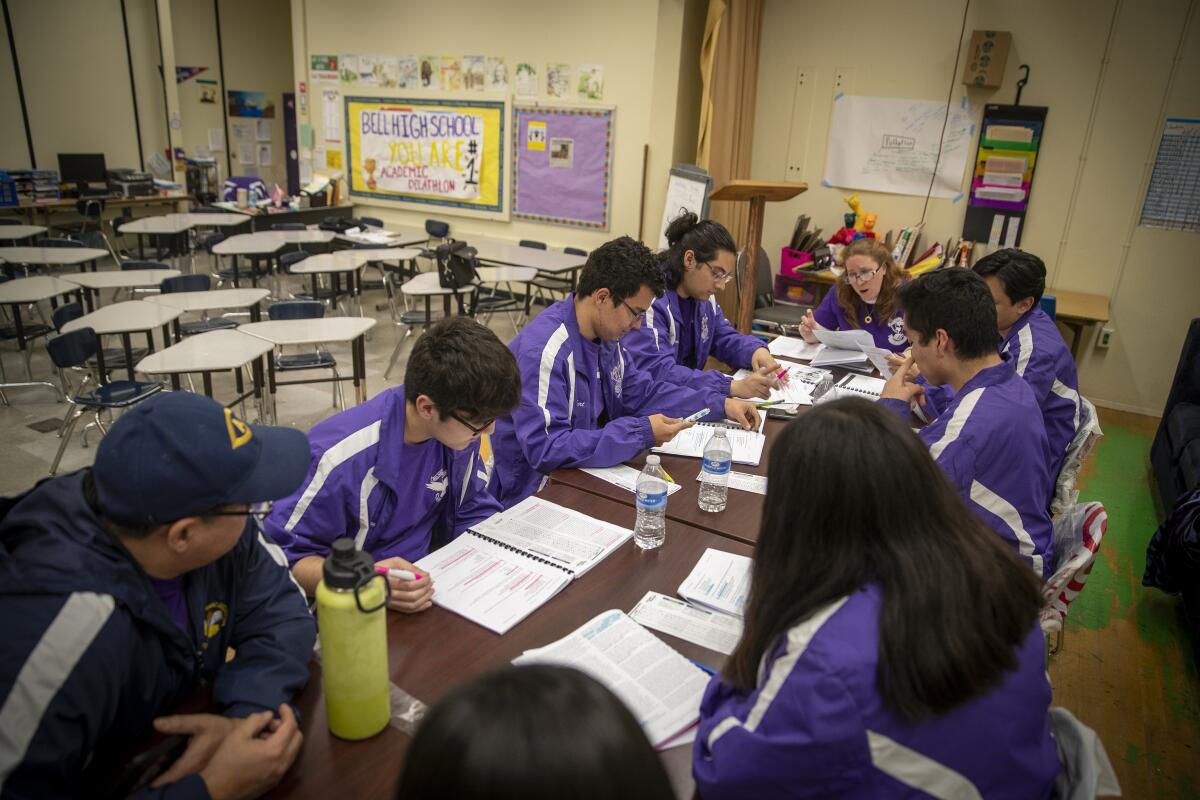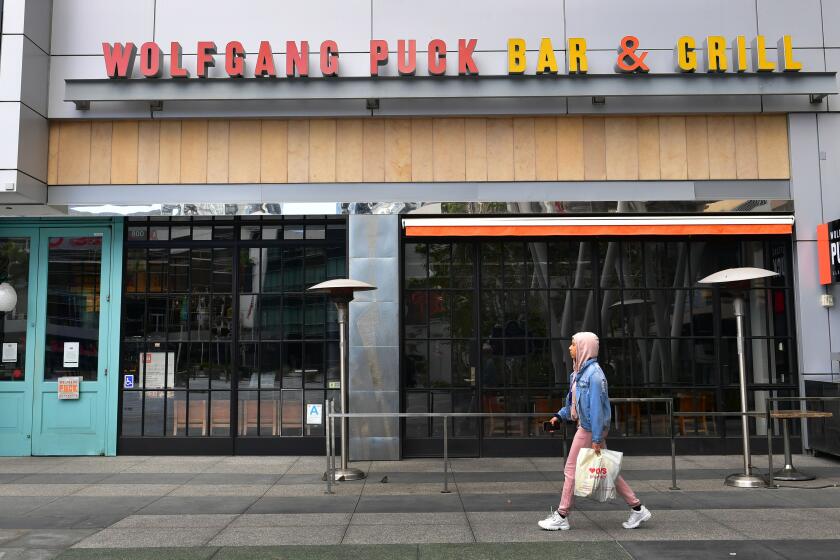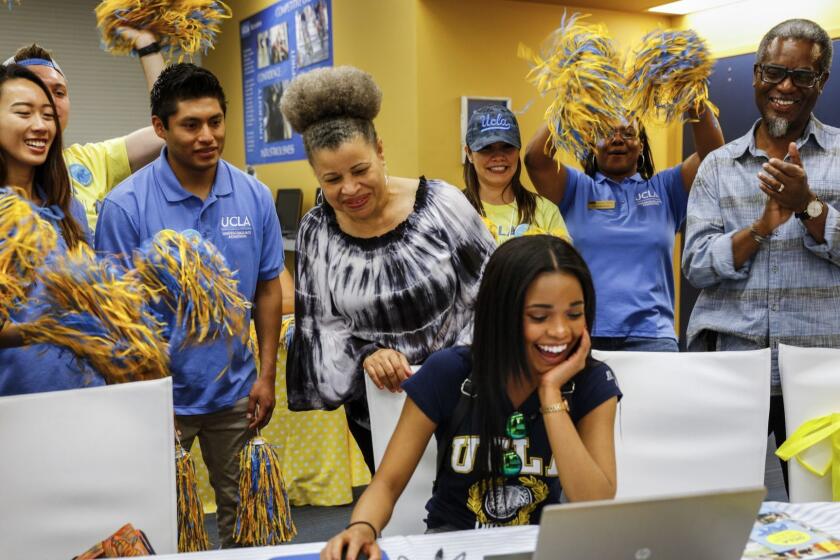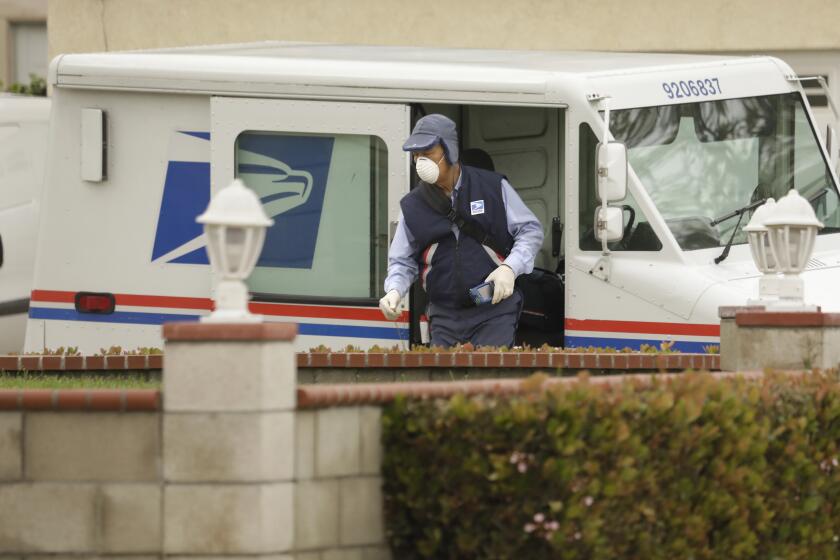Social distancing in a classroom? Newsom suggests major changes when schools reopen

- Share via
Although campuses are likely to reopen in the fall, the school day may unfold in starkly different ways, California Gov. Gavin Newsom said Tuesday, suggesting staggered start times, “reconfigured” classrooms that allow for social distancing and some continuance of online learning.
The governor said that physical distancing and other precautions against transmission of the coronavirus could remain in place for a lengthy period at schools after stay-at-home orders are lifted and California begins to gradually reopen.
School district leaders will need to begin considering a host of safety measures, he said.
“Can you stagger the times that our students come in so you can appropriate yourself differently within the existing physical environment — by reducing physical contact if possible, reducing the congregate meal, dressing issues related to PE and recess?” Newsom said. “Those are the kinds of things — those are the kind of conversations we’re all going to be having over the course of the next number of weeks and the next number of months.”
“We need to get our kids back to school,” he added. “I need to get my kids back to school. We need to get our kids educated.”
Such precautionary measures would have a profound impact on the experience of school for the state’s 6.1 million students in kindergarten through 12th grade as well as for students attending college. Since early to mid March, virtually all schooling in California has become “distance learning,” typically involving students and teachers interacting online.
Gov. Gavin Newsom laid out new guidelines for restaurants once the state’s stay-at-home orders are lifted.
The biggest concern has centered on the effect of the altered learning environment for students who lack computers, adequate broadband or suitable study conditions at home. Many school districts are loaning out computers and arranging for internet access. Los Angeles Unified is spending $100 million on computers and broadband hot spots for its students — 80% are members of low-income households.
State Supt. of Public Instruction Tony Thurmond said he’s encouraged by the governor’s optimism, the incremental progress in the fight against COVID-19 and the early thinking on reopening schools. All the same, he said, schools need to “continue working on distance learning,” make the most of the current school year and look at using the summer to address academic issues.
On Monday, L.A. schools Supt. Austin Beutner announced that campuses in the state’s largest school system would remain closed through summer, with online courses available. District officials also said Monday that no student would receive a failing grade for spring classes.
Beutner said Tuesday that it’s difficult to predict what schooling will look like in the fall: “The science continues to evolve and it changes — while maybe not by the day, almost by the day... And as we know more, we’ll be able to be more prescriptive and more detailed as to what our plans will be for reopening.”
Newsom’s comments sparked discussion about the challenges ahead.
School systems will confront a potential logistics nightmare when they reopen, said UC Berkeley education professor Bruce Fuller.
“Go slow,” Fuller suggested. “Invite 15 kids into a classroom with two adults. Use parent volunteers. Start with preschools and elementary schools. Younger children are more likely to conform to social distancing. Randomly test children and teachers each week to guard against a return of coronavirus.”
Gov. Gavin Newsom lays out the next steps in the weeks and months ahead in California’s fight against the coronavirus.
It’s hard to make a campus virus-proof, said UC Berkeley education and African American studies professor Janelle Scott.
“The ability of things to spread is just really not controllable,” Scott said, adding that it is not uncommon for parents to catch the bugs their children bring home. “You spend the first several years of school ... sick all the time.”
Fears over safety are likely to persist among both teachers and non-teaching staff, some of whom will be tasked with doing the deep cleaning needed to keep others safe, she said.
Such concerns are rooted in recent experience. In New York City, for example, at least 50 Department of Education employees have died from COVID-19.
Ongoing safety measures could feel scary, off-putting or threatening to students, said UCLA education professor John Rogers.
“It will be imperative for adults to talk with young people about why certain actions are being taken and to do so in a manner that expresses care and concern — rather than fear,” Rogers said.
USC education and psychology professor Erika Patall said that ultimately students may prove more adaptable than the adults.
Coronavirus has upended college decisions for high school seniors as they grapple with affordability, safety and family obligations
“It will still be stressful, and some kids are much more sensitive than others to change, but on average, kids will probably be happy to go back to school in any form,” Patall said.
The health situation underscores the importance of fully staffing schools with nurses, said Jeff Freitas, president of the California Federation of Teachers.
In his remarks, Newsom acknowledged that unions would be at the table in working through the myriad issues.
The challenge of a reimagined schooling experience will come at a difficult time, said Robin Lake, director of the Center on Reinventing Public Education at the University of Washington.
School districts could face steep budget cuts even as they are trying to help students recover from an almost inevitable learning loss or delay caused by the campus shutdowns and the transition to online learning, she said.
“If there’s ever been a time for innovation, it is now, and for kind of getting over worries about traditional boundaries,” Lake said.
No LAUSD students will receive failing grades this spring during coronavirus school closures as many have limited access to online learning.
In an altered school day, some students may need more time on campus than others, said UCLA education professor Tyrone Howard.
“There very well could be a hybrid model of school/home, but I would hope that there is consideration for students from low-income backgrounds who have less access to technology supports,” Howard said. “Perhaps there will be a staggered situation where some students are on a 70/30 school/home situation, whereas other students may be on a 50/50 situation. We’re going to have to be creative, flexible, and great listeners to the needs of vulnerable children and families.”
Former L.A. school board member Caprice Young sees opportunity in the moment.
“Let’s create more individualized instruction that is not based on the old factory model,” said Young, who has spent most of the last two decades working with privately managed charter schools. “Students should progress from grade to grade based on their competency in the subject matter, not how much time their seat has been in the seat. Some students learn best in small groups; others with one-on-one tutoring or through experimentation,” she said.
“Let’s build back better.”
Healthcare workers, grocery store employees, bus drivers, letter carriers — how to thank those helping society function during the COVID-19 pandemic.
More to Read
Sign up for Essential California
The most important California stories and recommendations in your inbox every morning.
You may occasionally receive promotional content from the Los Angeles Times.
















